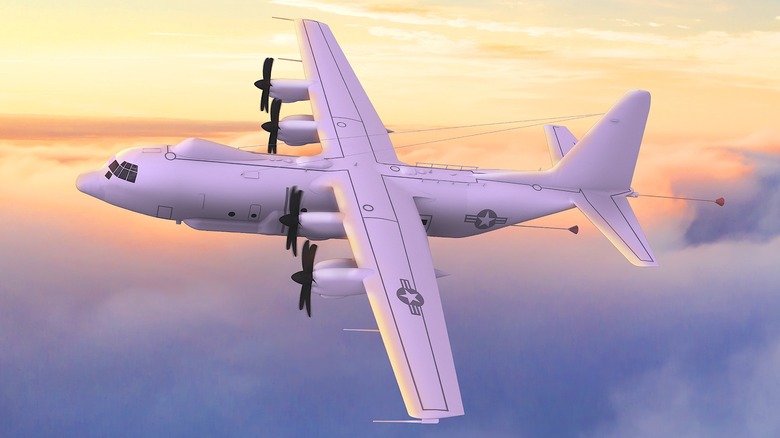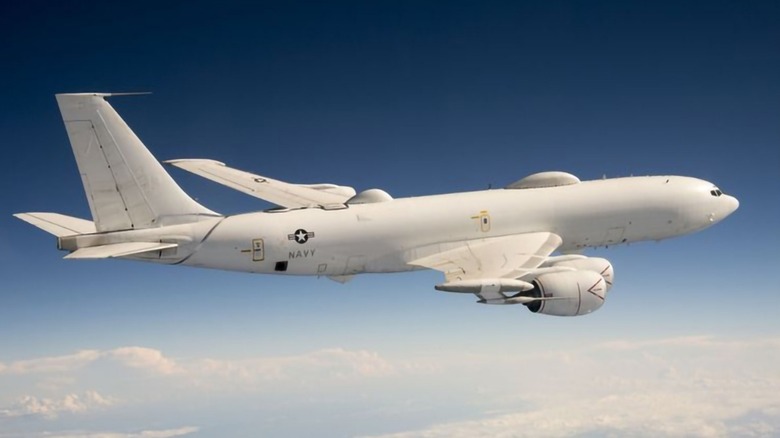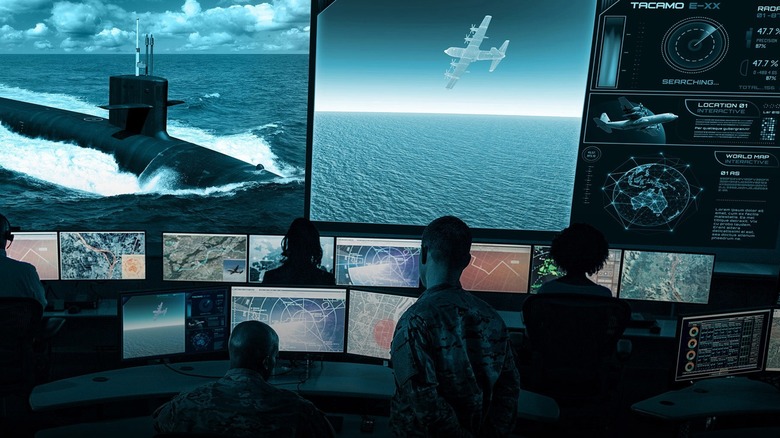Here's What Makes The US Navy's New Doomsday Plane So Special
The United States Navy maintains a fleet of aircraft that are unofficially called "Doomsday Planes." These are vital to national defense, and they serve an important strategic purpose. The current Navy aircraft designated for this mission is the Boeing E-6 Mercury, which is based on the Boeing 707-300. It's a mobile, airborne command post and operations center used as a survivable nuclear command, control, and communications (NC3) platform should ground and ship-based operability become compromised in a nuclear war, hence the moniker.
The Navy's Doomsday Planes are part of the U.S.' nuclear strategic operations, as they are capable of providing airborne command and control (C2) support to the fleet of Ohio-class nuclear ballistic missile submarines. The U.S. Air Force also operates its own fleet of Doomsday Planes, but the Navy has its own, as the service has different communications requirements due to its fleet of strategically hidden subs. Doomsday Planes have served the Navy for decades, and the current E-6 replaced earlier aircraft designated for the mission, but it's time to replace the aging aircraft.
In December 2024, the Navy awarded a nearly $3.5 billion contract to Northrop Grumman for its future fleet of Doomsday Planes. The aircraft chosen for this purpose is the E-130J, a propeller-driven aircraft, whereas previous platforms utilized jets. It will take some time for the E-130J fleet to surface, but in the meantime, Northrop Grumman is hard at work modifying existing aircraft for the Navy's purposes. When they're finally delivered, they'll continue the tradition of extending strategic nuclear communications well into the future.
The TACAMO mission
The U.S. Navy's program is called Take Charge And Move Out (TACAMO), which is responsible for the acquisition, maintenance, and operation of Doomsday Planes. The mission was launched in 1961 as a test program, and from the beginning, it was all about creating an airborne platform capable of Very Low Frequency (VLF) communications. Tests were done with a U.S. Marine Corps KC-130, and its success resulted in the full implementation of the TACAMO program with the Lockheed C-130G, a highly modified propeller-driven C-130 Hercules.
Initially, TACAMO aircraft were propeller-driven planes, but eventually, they were replaced with jets, though that will soon change back. The communications equipment has also advanced over the years, embracing new technology as it became available, though with heavy military modifications. Hundreds of officers and enlisted personnel worked in and around TACAMO planes for more than 40 years, amounting to over 380,000 flight hours of what the Navy calls "Class A mishap-free operations."
While the location of the squadron has changed over time, the mission has remained the same — ensuring the survivability of airborne communications with strategic assets. The future of the TACAMO aircraft now lies with Northrop Grumman. Upon awarding the contract, Secretary of the Navy Carlos Del Toro said, "Our TACAMO mission is foundational to our nation's Nuclear Triad. The E-130J will carry on the proud legacy of Navy TACAMO aircraft and keep our nation safe."
The E-130J TACAMO
The E-130J that is being designed and modified by Northrop Grumman is based on Lockheed Martin's Hercules, which was partially chosen because of its length. This allows for a greater crew capacity and equipment load. The system will be hardened against electromagnetic pulses (EMP). Additional hardening against cyberwarfare will make the aircraft as secure as possible. The most prominent feature will be a long wire extended from the tail attached to a drogue on the end. This will enable VLF communications at frequencies of 3-30 kHz with submerged submarines.
VLF communications can penetrate the ocean's surface to a depth of around 60 feet, enabling constant communications with subs. Because of the low bandwidth, the messages aren't complex and are instead Emergency Action Messages. These are preformatted messages executing nuclear forces to initiate specific major or limited attack options. All of this is intended for nuclear war, so in an ideal world, the Navy will never need to use TACAMO aircraft, but having them remains part of the deterrent that is the U.S.' nuclear triad.
Because of its unique mission, the E-130J will fly at slow speeds in a very steep and tight banking, which ensures the trailing VLF antenna flies as vertical as possible. This maximizes transmission with submarines, and the aircraft will repeat these turns for hours to ensure the messages are received. The Navy expects to replace its current fleet of E-6B Mercury aircraft with three new E-130J in fiscal year (FY) 2027 and six more in FY-28, ensuring a smooth transmission with no loss of mission capability.


